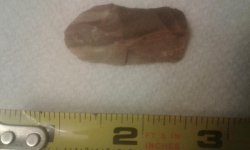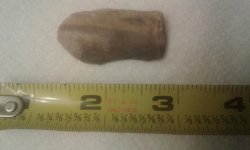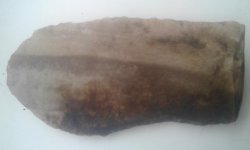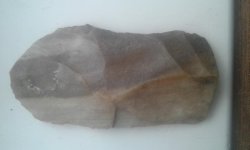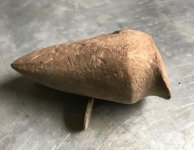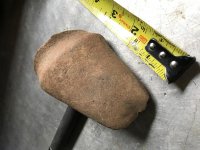You are using an out of date browser. It may not display this or other websites correctly.
You should upgrade or use an alternative browser.
You should upgrade or use an alternative browser.
Arrowhead or Nature?
- Thread starter Lee1968
- Start date
Ice Scratcher
Elite Member
- Joined
- Oct 13, 2012
- Messages
- 18,347
Certainly been worked...
Nice looking scraper!
<°)))>{
Nice looking scraper!
<°)))>{
metaladdict
Elite Member
Looks possibly native american.
Lawnwalker15
Senior Member
I agree with Ice Scratcher....you've got yourself a nice artifact there. Congrats!
graybeard
Elite Member
It looks like it is worked on one side. A better picture of the stone or flint would be better to tell, the tape measure shows more detail in the pictures then the stone.
Lee1968
Elite Member
graybeard
Elite Member
I took 2 more pics.....
Hopefully, these show more detail. Sorry, I am new to this.
View attachment 437616
View attachment 437617
The first picture I don't see any flaking, the second picture shows flaking.
Not everything they used for tools or points had flaking on both sides.
I would say you found an artifact.
Lee1968
Elite Member
Thanks for everyone's input on this. I appreciate your help!
Great site for new guys.
Great site for new guys.
jkbemdavis
Elite Member
I agree with the artifact assessment. Love finding the old stones that are made into points.
medicchief
Forum Supporter
Looks like something to me.....
Last edited:
Ice Scratcher
Elite Member
- Joined
- Oct 13, 2012
- Messages
- 18,347
Uniface scraper..
<°)))>{
<°)))>{
Sorry, but I have to disagree......it's an act of nature. I used to collect arrowheads and tools, then started flint-knapping myself. There really isn't any patina on the "flaked" side of the stone, it looks too "fresh/clean". Plus, it doesn't look pressure knapped to me at all. I could possibly make something from it though, but it's not really a desirable piece of stone to work with. Just my opinion and I could be wrong.....
Just cuz you are a modern day knapper doesn't mean you know anything about Paleo tools
medicchief
Forum Supporter
Just cuz you are a modern day knapper doesn't mean you know anything about Paleo tools
Read my entire post. I just offered my opinion and said I could be wrong. I prefer not to be judgemental of other people, as do the majority of people on THIS forum.
Last edited:
Read my entire post. I just offered my opinion and said I could be wrong. I prefer not to be judgemental of other people, as do the majority of people on THIS forum.
Ruffled your feathers I see.. I was no more judgemental than you..just my opinion that it's definitely not an act of nature because I see at least six places "nature" worked that stone..but I could be wrong...
longbow62
Forum Supporter
This is a utilized flake. You can clearly see a striking platform on the proximal end. Joe dert is correct the dorsal surface shows intentional flake removal.
medicchief
Forum Supporter
This is a utilized flake. You can clearly see a striking platform on the proximal end. Joe dert is correct the dorsal surface shows intentional flake removal.
I concur on the intentional flaking....the difference in the patina between the 2 sides is unusual....could have been reworked/sharpened or it's just the way it is. That said, I wish I found this early axe intact. They bring some good money. We live on Lake Dardanelle, which now covers the tail waters of the Illinois Bayou. I have found several artifacts on the 2 acres we have, which is on a hill next to the old bayou channel. I figure this may be from as early as the Archaic Period, but could be later. Arkansas does have Paleo history as well, but I don't think it's from that early. Who knows, I'm just a modern day knapper…..lol.

Attachments
longbow62
Forum Supporter
The staining looks like midden staining. If a artifact lies with one face or side in contact to dark midden this type of staining occurs. I have seen whole projectile points or knives darkened on the one side only from contact with middens. I have also seen concretions that only formed on one side of a artifact for what ever reason.
longbow62
Forum Supporter
By the way full groove axes like the one you found are the oldest form of ground stone axe. Overtime the grooving shifted to 3/4 then half groove to eventually no groove ground into them at all during the late Woodland and Mississippian periods.
Similar threads
- Replies
- 0
- Views
- 10


 Any thoughts would be appreciated. Thanks in advance!
Any thoughts would be appreciated. Thanks in advance!